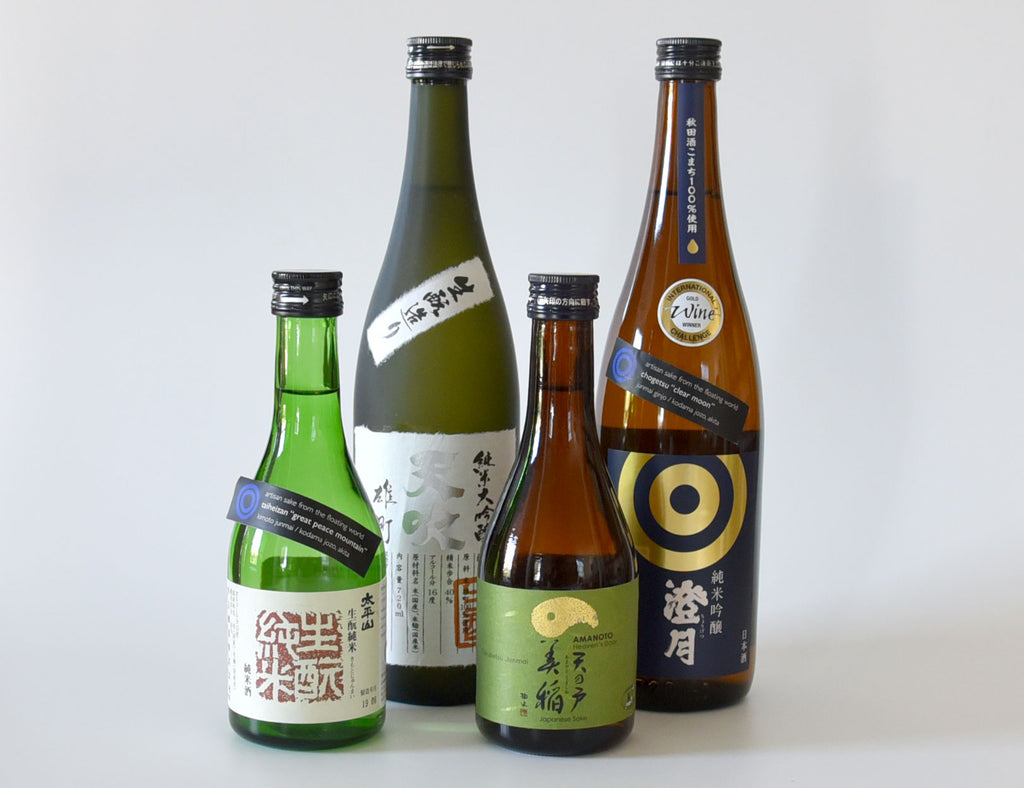
Sake Gumi is our monthly sake subscription service with 200 members throughout California. Join today!
This is Kayoko, Umami Mart co-founder, and Yoko’s sake sidekick. It’s that time of the year again, when I take over Sake Gumi for the month! This year, I wanted to embark on the subject of acidity in sake – its importance and impact on the final brew.Acid can be found in all alcohols, and sake is no different. Sakes do measure acidity levels, which normally falls between 1.0 to 2.0, with the average of around 1.3. In general, the acidity and SMV (sake meter value) work together to help determine the flavor profile of sakes. Brews with low acidity may be light and crisp, while the ones with high acidity can be more rich and robust (see chart).

Sake contains about a fifth of the acidity of wine. Wines have much more of the “sour” effect, leaving a drink that functions more as a palate cleanser, which is effective for richer, fattier dishes. In sake, due to its amino acids, the drink serves to support the food you are eating. Seafood is the best example of this, as I believe that it is far easier to pair with sake than with wine – sake supports the seafood, while the sourness of wine tends to destroy it.
These days, as wine has become big business in Japan, more brewers are making sakes with high acidity, in order to pair with many cuisines. I spoke with Yoshihiro Sako, founder of Oakland’s Den Sake Brewery, about acidity in sake, as his sakes are known to be relatively high in acidity. He began brewing in 2017 with the aim to make sake that would pair better with local California foods (more protein rich than in Japan). To do this, he manipulates the moromi during the fermentation stage to increase the acidity. His Batch 6 was 2.8 in acidity, wowza! While Den sakes aren’t offered in Sake Gumi (his bottle size is 500ml), we’ll host Den Brewery’s Batch 8 Release Party with Sako on Sunday, October 20th. Please join us and ask Sako himself about acidity in sake!
Our sakes this month are all above 1.5 in acidity. Both Level 1 and 2 have sakes by Kodama Jozo in Akita, known for their kimoto sakes. Since kimotos and yamahais create naturally occurring lactic acid, the acidity levels will tend to be high. All of our sake selections had a markedly wine-like characteristic about them, whether they were floral on the nose, or grape-like juiciness. While I think it’s dangerous to make too many comparisons between sake and wine, there’s no doubt that acidity plays a part in how we enjoy our local California cuisine with sake.
Kanpai,
Kayoko
LEVEL 1: Introductory Membership (Two 300ml bottles)
 Ama no To “Heaven’s Door”
Ama no To “Heaven’s Door”
Tokubetsu Junmai
Asamai Brewery (Akita, Japan)
Seimaibuai: Ginnosei 55%, SMV: +4, Acidity: 1.5
Attention junmai lovers! This is a delicious, balanced brew with a velvety body. While floral on the nose with hints of spice, it has an ume-like tartness and a dry ending. The kurabito (sake brewers) at Asamai also grow their own rice – this selection is an homage to the toji (master brewer) who passed last month suddenly while working in their rice field. He made sakes to specifically support a meal, and in our case, it was a simple margherita pizza with anchovies. Drink at room temperature.
 Taiheizan “Great Peaceful Mountain” Kimoto Junmai
Taiheizan “Great Peaceful Mountain” Kimoto Junmai
Kodama Jozo (Akita, Japan)
Seimaibuai: Miyama Nishiki 59%, SMV: +3, Acidity: 1.7
Creator of the “Akita Kimoto Method”, Kodama Jozo is revered for its sakes. The nose on this sake is distinctly a kimoto – lactic, yeasty, with a grape-like juiciness. However, we called this a “Kimoto Light” as the body is quite crisp with a slight creaminess that paired well with radishes and butter, and celery salad. The Kodama family recommends Chinese food! Try this one warm.
LEVEL 2: Premium Membership (Two 720ml bottles)
 Chogetsu “Clear Moon” Junmai Ginjo
Chogetsu “Clear Moon” Junmai Ginjo
Kodama Jozo (Akita, Japan)
Seimaibuai: Akita Sake Komachi 55%, SMV: +1, Acidity: 1.6
Crisp and clean, this sake is meant to be enjoyed cold, in a wine glass, Eiko Kodama of the brewery told me. She said that they deliberately wanted to make it wine-like so they increased the acidity using the kimoto method. The result is a bright, floral nose with a minerally mouthfeel that paired well with crudite, hirame carpaccio, and pickled corn.
 Amabuki Kimoto Omachi Junmai Daiginjo
Amabuki Kimoto Omachi Junmai Daiginjo
Amabuki Shuzo (Saga, Japan)
Seimaibuai: Omachi 40%, SMV: +1, Acidity: 1.9
This sake clocks in at the highest acidity of the four bottles, and was a favorite for Yoko and me. It must be the Omachi rice! We learned a few months ago that Omachi is Japan’s oldest sake rice, producing sakes that are grassy and herbaceous – they are unique and we enjoy them. Made in the kimoto style, using yeast from Rhododendron flowers, notice the grape-like acidity and citrus zest, with a sharp ending. Try it cold with blue cheese and tomato toast.




Comments (0)
There are no comments for this article. Be the first one to leave a message!